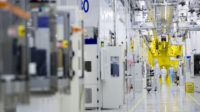Intel's two semiconductor plants under construction at its Ocotillo campus in Chandler, Ariz.—and expected to come on line in 2024—are intended to help relieve the U.S. shortage of microchips. The $20-billion project is even larger than the firm's previous Arizona plant.
The 700-acre campus will contain a total of six plants, known as “fabs,” with the addition of Fab 52 and Fab 62, for which.the Santa Clara, Calif.-based tech company announced official groundbreaking on Oct. 1. It says the expansion will help the U.S. regain ground in semiconductor manufacturing and alleviate some supply chain issues related to microchips. As ENR previously reported, a shortage of microchips and semiconductors has forced automakers to slow production.
Intel also says the new plants will support its Intel Foundry Services, which won a U.S. Dept. of Defense contract in August to develop and fabricate advanced processing chips.
“As the only U.S.-based leading-edge chipmaker, we are committed to building on this long-term investment and helping the U. S. regain semiconductor leadership,” Intel CEO Pat Gelsinger said in a statement.
Both the designer, Jacobs Engineering, and the general contractor, Hoffman Construction, worked on other Intel projects, including the latest addition at the Chandler site, Fab 42, which opened last year.
Not a Typical Factory Job
Intel’s fabs are typically 70 ft tall, the company says. Each one consists of a clean room level, where the computer chips are produced, and three levels that support the clean room: one above it to filter the clean room’s air, one below the clean room containing systems like power and gas for production equipment and a utility level on the bottom with utility mains plus the chiller and compressor systems.
Fab 42 was tied as Intel’s largest fab at the time of its construction at 1.3 million sq ft, according to Hoffman. More than 4,000 workers used 120,000 cu yd of concrete and 12,000 tons of steel to build the fab in 16 months.
The scale of Fab 42, and the Arizona summer heat, required Hoffman to use special construction techniques. Workers would cast concrete at 1 a.m., using ice in the mix, the builder says. It also had to use modular and prefab construction processes, shipping in components to be installed in racks that were each 166 ft long and 90 tons when completed.
The project currently underway is even larger. Dominic Greensmith, director of construction at Intel, says the builders will use 400,000 cu yd of concrete and 40,000 tons of steel. Intel also says it expects the project will support 3,000 construction jobs.






Post a comment to this article
Report Abusive Comment